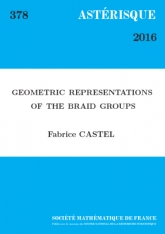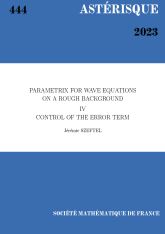Représentations géométriques des groupes de tresses
Geometric representations of the braid groups

- Consulter un extrait
- Année : 2016
- Tome : 378
- Format : Électronique, Papier
- Langue de l'ouvrage :
Anglais - Class. Math. : Primary 20F38, 57M07. Secondary 57M99, 20F36, 20E36, 57M05
- Nb. de pages : vi+175
- ISBN : 978-2-85629-835-0
- ISSN : 0303-1179
- DOI : 10.24033/ast.980
On appelle représentation géométrique toute représentation d'un groupe dans le groupe de difféotopies, couramment appelémapping group, d'une surface. Soient $\Sigma _{g,b}$ la surface orientable, compacte et connexe de genre $g$ possédant $b$ composantes de bord et $\mathop {\mathcal {PM}\mathrm {od}}(\Sigma _{g,b})$ le groupe de difféotopies associé préservant chaque composante de bord. Le but de cet article est de décrire l'ensemble des représentations géométriques du groupe de tresses $\mathscr {B}_n$ à $n\geqslant 6$ brins dans $\mathop {\mathcal {PM}\mathrm {od}}(\Sigma _{g,b})$, pour tous $n$, $g$, $b$ pourvu que $g\leqslant n/2$. On prouve que sous cette seule condition, de telles représentations sont soit cycliques, c'est-à-dire d'image cyclique, soit des transvections d'homomorphismes de monodromie, c'est-à-dire qu'à multiplication près par un élément du centralisateur de l'image, l'image d'un générateur standard de $\mathscr {B}_n$ est un twist de Dehn, et l'image de deux générateurs standards consécutifs sont deux twists de Dehn le long de deux courbes s'intersectant en un point. De nombreux corollaires en découlent. On les prouvera dans de futurs articles, mais on explique ici comment chacun se déduit de notre théorème principal. Ces corollaires concernent cinq familles de groupes : les groupes de tresses $\mathscr {B}_n$ pour tout $n\geqslant 6$, les groupes d'Artin de type $D_n$ pour tout $n\geqslant 6$, les groupes d'Artin de type $E_n$ pour tout $n\in \{6,7,8\}$, les groupes de difféotopies $\mathop {\mathcal {PM}\mathrm {od}}(\Sigma _{g,b})$ (préservant chaque composante de bord) et les groupes de difféotopies $\mathop {\mathcal {M}\mathrm {od}}(\Sigma _{g,b},\partial \Sigma _{g,b})$ (préservant le bord point par point), pour tout $g\geqslant 2$ et $b\geqslant 0$. Pour chacune de ces familles, excepté les groupes de type $E_n$, on décrira précisément la structure (toujours remarquable) des endomorphismes, on déterminera les endomorphismes injectifs, les automorphismes et le groupe d'automorphismes extérieurs. On décrira également l'ensemble des homomorphismes entre groupes de tresses $\mathscr {B}_n\to \mathscr {B}_m$ avec $m\leqslant n+1$ et l'ensemble des homomorphismes entre groupes de difféotopies de surfaces (éventuellement à bords) dont les genres (supérieurs à 2) diffèrent d'au plus 1. Concernant les groupes d'Artin de type $E_n$, on décrira toutes leurs représentations géométriques, et l'on déduira d'un théorème de Waynryb qu'aucune n'est injective.


